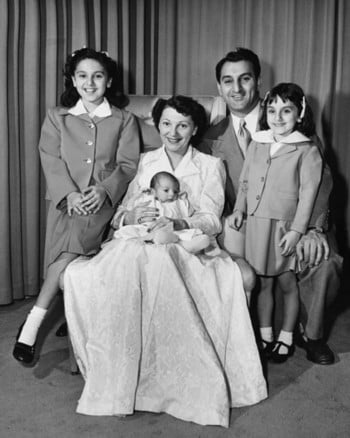 |
| Danny & Rose Marie Thomas with children (left to right): daughter, Marlo; son, Tony; daughter, Terre. Image courtesy of St. Jude Children's Research Hospital |
I initially hesitated when I was asked to write about Rose Marie Thomas who with her husband, the legendary Danny Thomas, founded St. Jude Children’s Research Hospital® in Memphis, Tennessee in 1962. However powerful words may be, I asked myself if I could really put onto paper how wonderful and meaningful it was to have had her in my life from infancy into adulthood. Remarkable as she was then, her legacy continues more than a hundred years since her birth.
To me, she was always Aunt Rosie, even when I could pronounce Rose Marie. Full of life and love, she never faltered in her quest to love and cherish that which she held near to her heart. Early on, I learned from Aunt Rosie the value of love, a giving heart; of giving to those who need help; and the importance of a sense of humor. She always had the right words at the right time. Like her husband, Danny Thomas, she too was an engaging storyteller.
"Never take yourself too seriously," she told me when I told her I wanted to be a photojournalist covering important world events. "And never take anything for granted," she reminded me, again and again.
Born Rose Marie Cassaniti in 1914, Aunt Rosie was a talented singer with her own radio show in Detroit, Michigan. There, she met Amos Jacobs, who took his brothers’ names for his stage name, Danny Thomas. He was a young, up-and-coming comic and they were married on January 15, 1936. Even though she ended her singing career to take care of her three children, Marlo, Terre and Tony, she always found time for those in need. Besides mothering three remarkable people, another one of her important contributions was her involvement in fundraising for St. Jude Children's Research Hospital ® - now a world-renowned research and treatment facility for childhood cancer and other catastrophic diseases.
Their goal became their life’s work. They wanted sick children to have free care. After Danny Thomas became a successful actor in the early 1950s, she traversed the United States with him, raising money to build his dream - St. Jude Children's Research Hospital ®. As they drove around the country, they would stop in gas stations where they would change their clothes before meeting with prospective donors. Not only was this a labor of love, it was as grassroots as you could get. In the beginning, it was just the two of them and their secretary. For many years, that was the entire organization raising funds to build a hospital where kids could get free care.
When St. Jude Children's Research Hospital® opened in 1962, the most typical form of childhood cancer, acute lymphocytic leukemia (ALL) was survived by less than five percent of the children diagnosed with the disease. Mainly because of discoveries and research done at St. Jude, the survival rate is more than 90 percent today. How amazing is that?
St. Jude Children's Research Hospital® has never turned away a patient because of their inability to pay for treatment. For her work and dedication in raising funds to help support the research and care given at St. Jude, Rose Marie Thomas was named Lady Commander with Star of Knights of the Holy Sepulchre by Pope Paul VI. And Danny Thomas was awarded a Congressional Gold Medal of Honor, the highest civilian award given by Congress, for his dedication to saving children's lives.
Rose Marie was also a life member of St. John's Hospital and Health Center Guild, a perpetual member of the Mary and Joseph League, the Maronite Guild, the Screen Smart Set Auxiliary for the Motion Picture and Television Relief Fund, the National Conference of Christians and Jews, the Eucharistic Orphanage of Lebanon and the Women's Auxiliary of Permanent Charities of the Entertainment Industry.
After a little more than half a century after opening its doors, the goal at St. Jude Children’s Research Hospital® remains the same; finding cures and saving lives. As the one building hospital has grown into a major medical center, the treatments and discoveries pioneered there are shared freely across the globe. Because of the generosity of donors, families never receive a bill for care. Treatment, travel, housing and food are all taken care of so that no family needs an additional burden.
Happy birthday to one of the dearest people ever.
 |
| Image courtesy of St. Jude Children's Research Hospital |
Page created on 12/27/2011 1:43:18 PM
Last edited 3/6/2020 5:02:52 AM
About Childhood Cancer
Childhood cancer typically refers to a cancer that is found in children and teens, and sometimes young adults. There are many types which can be found in different places throughout the body. Leukemia, a type of blood cancer, is the most common cancer in children. Cancer can also occur in organs and tissues such as the lymph nodes (lymphoma), nervous system (brain tumors) and muscles, bone and skin (solid tumors). Research efforts are directed at understanding the molecular, genetic and chemical bases of catastrophic diseases in children; identifying cures for such diseases; and promoting their prevention. Research is focused specifically on cancers, some acquired and inherited immunodeficiencies, sickle cell disease, infectious diseases and genetic disorders.
It will cost approximately $1 billion to operate St. Jude this year and the majority of that must come from generous donors. St. Jude has more than 3,600 employees, and there are currently 24 official partner sites in 17 different countries around the world.
St. Jude Today
St. Jude Global helps partner medical institutions develop tailored evidenced-based protocols for treating children with cancer and other catastrophic diseases. St. Jude physicians serve as mentors to physicians at partner sites and consult on difficult cases. They train nurses in the best practices in clinical care and work with pathologists on techniques for accurate diagnosis. They also partner with local fundraising foundations that support the medical programs. This model has proven to be highly effective in providing children in developing countries access to modern treatment and care. St. Jude also conducts long-term biostatistical investigations on the long-term outcomes of its patients and is the only pediatric research hospital that has been awarded a National Cancer Institute cancer center support grant. The St. Jude Affiliate Program also makes treatments developed as clinical trials at St. Jude Children’s Research Hospital® available to more children by offering much of the care close to home at hospitals around the U.S.
St. Jude continues to define the forefront of clinical care and research by aligning with Rady Children’s Hospital, San Diego. The unique alliance is designed to benefit both patient care and research efforts. It will enable St. Jude and Rady Children’s to combine their resources and expertise to pursue clinical trials.
Some of the highlights of what has occurred at St. Jude Children's Research Hospital® over the last twenty plus years include:
- St. Jude announced a new $412 million research center to advance discoveries against childhood cancer and other life-threatening diseases (2018).
- St. Jude launched the St. Jude Cloud, the largest public repository of pediatric cancer genomics data, launches for researchers worldwide (2018).
- St. Jude was named the World Health Organization's first Collaborating Centre for Childhood Cancer (2018).
- St. Jude expanded its international reach with St. Jude Global to accelerate efforts to improve childhood cancer survival rates worldwide (2018).
- The World Health Organization and St. Jude announced a new global childhood cancer effort to cure at least 60 percent of children with six of the most common kinds of cancer worldwide by 2030 (2018).
- St. Jude opened the first proton therapy center dedicated solely to the treatment of children (2015).
- In a landmark study from St. Jude and Washington University in St. Louis, investigators found that 8.5 percent – nearly one in 10 – of patients studied was born with genetic changes or mutations that increased their cancer risk (2015).
- The Pediatric Cancer Genome Project was recognized as one of TIME magazine's top 100 new scientific discoveries (2013).
- The Pediatric Cancer Genome Project released the largest-ever compilation of whole genome data for free access by the global cancer research community (2012).
- A national study led by St. Jude shows that a drug commonly used to treat sickle cell anemia in adults is safe and effective in very young children – a dramatic advance in treatment of children with the inherited blood disorder (2011).
- St. Jude was the first children’s hospital to make a major investment in pediatric cancer genome sequencing. The St. Jude Children’s Research Hospital – Washington University Pediatric Cancer Genome Project has resulted in groundbreaking discoveries in several childhood cancers and laid the foundation for developing new treatments. Before this project, not even one pediatric cancer genome had ever been sequenced (2010).
- St. Jude pioneered the elimination of cranial irradiation in treating most leukemia patients, greatly reducing immediate and long-term effects in these patients (2009).
- St. Jude becomes the first and only pediatric cancer center to be designated as a Comprehensive Cancer Center by the National Cancer Institute (2008).
- St. Jude reported a 94 percent survival rate for a group of patients with acute lymphoblastic leukemia (ALL), a dramatic increase over the 1962 survival rate of 4 percent (2006).
- St. Jude measured the effect of radiation on a child's brain for the first time in a pioneering study of pediatric brain tumor patients (2001).
- Peter C. Doherty, PhD, chair of the St. Jude Department of Immunology, won the Nobel Prize for Physiology or Medicine for his groundbreaking work in the field of immunology (1996).
- The first bone marrow transplant in the world to treat osteogenesis imperfecta, a rare bone disease, was performed at St. Jude (1996).
- St. Jude became the first hospital in the world to perform gene therapy on a pediatric brain tumor patient (1995).
- St. Jude was the first to study a computer-based three-dimensional radiation therapy technique for pediatric brain tumor treatment to minimize damage to healthy tissue and preserve cognitive development in children (1995).
